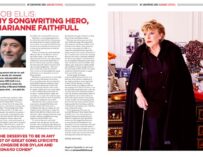
Lisa Redford. Pic: Mui Tsun
Need a break from writing? Our regular columnist looks at the fine art of making a familiar song your own…
![]() his year I performed a live session for Bob Harris and WBBC, where guests were requested to perform the first cover they ever learned. This got me thinking about the perennial popularity of artists recording covers. People have done this for years – The Beatles and The Rolling Stones started their careers performing rock, blues and R&B covers, and indeed the Stones’ first UK No 1 was a cover of Bobby Womack’s It’s All Over Now, while The Beatles’ early albums featured songs by Buddy Holly, Little Richard and Carl Perkins. And today, with major artists performing live covers for Radio 1’s Live Lounge, and Radio 2 recently choosing their favourite covers of all time, they’re arguably even more popular than ever.
his year I performed a live session for Bob Harris and WBBC, where guests were requested to perform the first cover they ever learned. This got me thinking about the perennial popularity of artists recording covers. People have done this for years – The Beatles and The Rolling Stones started their careers performing rock, blues and R&B covers, and indeed the Stones’ first UK No 1 was a cover of Bobby Womack’s It’s All Over Now, while The Beatles’ early albums featured songs by Buddy Holly, Little Richard and Carl Perkins. And today, with major artists performing live covers for Radio 1’s Live Lounge, and Radio 2 recently choosing their favourite covers of all time, they’re arguably even more popular than ever.
Covers often reveal something about the artist, while some have even become the definitive version of the song. I’ve performed and recorded covers since I started, choosing songs that have resonated with me and to which I felt I could bring something different while maintaining my own style. But how do you cover a song while bringing something new and creative? Among the abundance of covers, which are the most enduring and and memorable?
If you’re covering a song, there are a few ways to bring something fresh, whether it be experimenting with different keys, using different time signatures, or transporting the song into another genre – or another gender. UB40 brought their inimitable reggae sound to classic songs such as Neil Diamond’s Red Red Wine (albeit they weren’t the first to do so with that particular song), while French group Nouvelle Vague have made a career out of taking tracks from new wave bands such as XTC, Depeche Mode and Joy Division and stripping them down to acoustic arrangements in a lounge-y, bossa nova style. Jose Gonzalez altered The Knife’s hypnotic, electronic Heartbeats into his signature style of classical guitar with soft vocals.
“Adding embellishments or altering tempo can have a dramatic impact”
Adding embellishments, such as incorporating some seventh major and minor chords to common chords, or altering tempo and feel, can also have a dramatic impact. In 2001 Michael Andrews and Gary Jules brought a much slower and minimalist mood to Tears for Fears’ Mad World for the Donnie Darko soundtrack. Turning an epic-sounding song into something more small and intimate will also show the song in a new light. A great example is Eva Cassidy’s emotional and acoustic rendition of Over The Rainbow: the combination of her beautiful voice and guitar brought an incredible intimacy to one of most enduring standards of the 20th Century.
Covers can really tug at the emotions, and to many music fans even become more revered than the original. Leonard Cohen’s Hallelujah (1984) is one of the most covered and reworked songs of recent years. I’ve performed the song live with US artist Eve Selis. Inspired by John Cale’s cover for a tribute album, Jeff Buckley’s emotional and moving version from the album Grace in 1994 has become so celebrated it’s included on Rolling Stone‘s list of The 500 Greatest Songs of All Time. Where Cohen’s has a more sardonic delivery, Buckley’s amazing tenor voice over a sparse electric guitar is full of passion and tenderness.

Pic: Mui Tsun
Covers can be so powerful that they even make an impression on the original writer. Bob Dylan’s All Along The Watchtower from 1967 is a dark, acoustic-driven track with apocalyptic lyrics. Jimi Hendrix’s version, recorded a year later, makes an immediate impact and also features on Rolling Stone’s greatest songs list. Possessing a raw energy and urgency, while displaying Hendrix’s incredible guitar playing and inventive riffs and solo, Dylan’s reaction reflects how blown away he was: “It overwhelmed me, really…he could find things inside a song and vigorously develop them. He found things that other people wouldn’t think of finding in there. He probably improved upon it by the spaces he was using.” The track became Hendrix’s best-selling single and even resulted in Dylan playing his own version “heavier” from then on, saying, “Ever since he died I’ve been doing it that way… strange how when I sing it, I always feel it’s a tribute to him in some kind of way.”
There are other examples of finding what you can identify with when attempting a cover and applying your own sound to it. Nine Inch Nails’ song Hurt (1994) is a Grammy-nominated rock song written by Trent Reznor. Full of anger and pain, it conveys a young man’s heroin addiction. In 2002, Johnny Cash’s critically acclaimed version gave the song a whole new meaning; his interpretation, an old man reflecting on his life experiences, combined with his distinctive voice and Rick Rubin’s stripped down production, feels like it was written for Cash and his 70 year old self. Reznor was also moved by Cash’s version once he felt the impact of the touching video which captured Cash in his youth and frail older years: “It really made me think about how powerful music is as a medium and art form. I wrote some words and music in my bedroom as a way of staying sane, about a bleak and desperate place I was in. That winds up reinterpreted by a music legend from a radically different era/genre and still retains sincerity and meaning – different, but every bit as pure.”
“You can change the context for your own interpretation”
As well as identifying with what the original is trying to convey, you can change the context for your own interpretation. Dolly Parton’s Jolene (1973) has been recorded more than any song she’s written and countless artists have put their own spin on the tale of the stunning auburn-headed, green-eyed lady. White Stripes released their intense live version as a single in 2004, of which Jack White says: “I thought to take the character and change the context and make this red-headed woman my girlfriend, and that she’s cheating on me with one of my friends. Then, that would be what I could really get emotionally attached to.” But Mindy Smith’s affecting cover is Parton’s favourite version of the song – mine, too! – and Smith says she related to the woman pleading with Jolene. “I think the main character is really the person singing about Jolene. Jolene’s a mess. She just steals things.”
Covers can provide you with an interesting challenge to try something different and creative with an established song, whether vocally or in the arrangement and instrumentation. Covering a great song can provide inspiration for your own writing by stepping into another writer’s world. Choosing a particular song can also tell your audience something about you as an artist, revealing your musical tastes, while bringing your own interpretation, identity and style to it, as kd lang has pointed out: “As a songwriter you have an umbilical cord to the song and it’s hard to expand on your understanding of the lyrics. Whereas when you cover a song you can create your own reason why you’re attached to it.’
I’d love to hear what your favourite covers are and why, and which ones you enjoy performing and recording.
Regular Songwriting columnist Lisa Redford has been described by BBC Radio 2′s Bob Harris as “one of our finest singer/songwriters.” She has earned acclaim for her heartfelt acoustic music with gorgeous melodies and pure, soulful vocals. You can see the video for one of her own cover choices – a ukelele version of The Supremes’ Someday We’ll Be Together – below.
For more information and to hear more of her music, visit Lisa’s website, or find her on Twitter, Facebook, YouTube, Reverbnation or Bandcamp.




































A lot of what Lisa says is common sense BUT as an article itself she explains the how’s and why’s.
Its an unofficial guide to doing cover versions which would only help improve the quality of ones own writing.
I have re-read this article a few times and learned more each time.
A lot of this I already knew but when someone like the writer joins it all together in the article then its much easier to understand and more importantly to act on her advice.